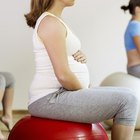Pain Relief for Pregnant Women With Breech Position Babies
Most full-term babies will take a head-down position before labor. However, approximately 3 percent of full-term babies are in a breech position -- head up instead of head down -- when labor begins. Because the pressure of your baby's head on your cervix is an important factor that helps your cervix to dilate and labor to progress, a vaginal birth with a breech baby can be more difficult and painful, and many mothers with breech babies opt for a surgical cesarean section.
Home Pain Relief
If you are uncomfortable during pregnancy because of your baby's breech position, the best solution for pain is to attempt to turn your baby out of the breech position. This is recommended whether you are in pain or not, as the breech position is more difficult and dangerous for labor. Pregnancy exercises such as a pelvic tilt, in which you get on your hands and knees and flex your back up and down, can sometimes help encourage your baby to turn. If your baby's kicking causes pain or bruising, ask your doctor about safe medication for treatment.
Doctor's Assistance

Exercises With an Exercise Ball to Help Induce Labor
Learn More
If your baby continues in the breech position, your care provider might attempt to turn your baby using an external version; your doctor will try to move the baby into a head-down position by pressing on your abdomen. A chiropractic method called the Webster technique -- which reportedly is 75 to 95 percent effective -- helps correct misalignment in your pelvis and lower back, relaxing your uterus so your baby can turn head-down. In one study cited in the July/August 2002 issue of "The Journal of Manipulative and Physiological Therapeutics," the Webster technique had an 82 percent success rate of turning breech babies.
Natural Pain Relief During Labor
If you choose to give birth to your breech baby vaginally, you will have the same options for pain relief that you would have for labor with a head-down baby. Vaginal birth is more dangerous for a breech baby than for a head-down baby, so discuss all the possibilities with your care provider before you decide to have a vaginal birth. Take a childbirth class to learn natural pain-relief methods like breathing techniques, visualization and self-hypnosis. You can also have a doula or coach who is skilled in labor techniques like massage and aromatherapy. Many breech babies will turn during labor, and the position that feels most comfortable to you will probably be the position that will help the baby turn, if possible.
Medical Pain Relief During Labor

Repercussions of Exercising Too Soon After a C-Section
Learn More
Since labor with a breech baby can be more difficult and painful than with a head-down baby, some care givers recommend that you plan to get medical pain relief including an epidural. You will need the epidural or a regional anesthetic if you choose to have a cesarean section. In addition, cord prolapse, in which the cord comes out before the baby is born, is more likely to occur with a breech baby. If this happens in a planned vaginal birth, you will need an emergency cesarean section, so be prepared for medical pain relief even if you want an unmedicated birth.











